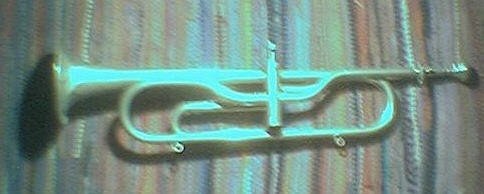
Proximal Parp emerges out of several ongoing preoccupations whilst continuing a tradition of primal horn blowing that as far as I recall began circa 1978 when I added various conch shells to my percussion array. In Metgumbnerbone we used several tubes, bones, shells, pipes & animal horns after the fashion of ceremonial folklore - everything from the ritual trumpets of Tibet to the ram's horn blown at Ascension Eve in Whitby, North Yorkshire after the completion of the Penny-Hedge.

I never considered owning a conventional instrument until the autumn of 2001 when, whilst recovering from food poisoning, I had a dream in which we saw a one-valve trumpet in an antique shop for £20. Upon waking I described my dream to Rachel as an example of how ill I must have been, and she replied that I must have been ill, because we did indeed see a one-valve trumpet in an antique shop in St. Helen Aukland whilst driving home the day before. Needless to say we lost no time in returning to the shop & purchasing this most singular instrument.

To this day, no one has been able to tell me anything about this trumpet, its provenance or its purpose. Several people (trumpet players) have commented on the absence of a spit-valve, though the instrument is so designed that the valve column itself serves this particular purpose very efficiently. If anyone chances upon this who can offer me any further information on this instrument then I'd be very grateful. For the record the bell is stamped crudely with the name AVORA & the instrument seems to pitched in a military Bb. Email monovalve@sedayne.co.uk

After persevering with the Aukland Horn for almost a year I decided to start looking for something a little more conventional; setting my heart on a pocket trumpet / cornet owing partly to my love of Don Cherry - something small & intimate, something personal & maybe not so very expensive either. In the end, the answer came via EBAY where very cheap Indian pocket-cornets are readily available at auction. The instrument arrived back in September & having immediately fell in love with it (and purchased a Harmon mute that cost almost as much as the instrument did itself) I set about using it in the various aspects of my music, including the wee tour Venereum Arvum did with Angel Hire Wires in early October.




Culturally, the horn is close to my heart; hunting horns, the muted-trumpets of 1920's English dance bands, the Mariachi stylings of Ennio Morricone's western scores and the cornett playing of Frantisek Pok & Ian Harrison all have a particular resonance for me. Whilst all of these have served to inspire, in acquiring my own vocabulary for the pocket cornet I have done so largely without referencing to other music other than my own; hence Proximal Parp, in which I explore the diversities of harmonics & timbre without bothering too much about conventional technique - heaven knows there are enough people doing that without me doing it too. Uniqueness intrigues as potential unfolds, which is what music is about although in this day & age I fear there is far too much emphasis on formula & celebrity for music to have any real or inherent value; in a world where everyone seems to be selling their souls in a bestial clamour for status & recognition (regardless of ability or vision) I take time to reflect upon the simple joys of setting into vibration a column of air contained within several integrated lengths of brass tubing - an immediate significance that resonates through time & by which I might create something of a music in the glad immediacy of circumstance which, even though I say so myself, is possessed of a primal & elemental beauty by which the creative process is charged to endure regardless of the latest trends and marketing strategies.

There are four pieces contained on Proximal Parp. The first & fourth are variations of the same basic harmonic idea, the second is the source of the loop that accompanies this page, and the third is the basic horn & organ track that Rachel & I recorded for an aborted version of The Old Grey Song & which appears on the Venereum Arvum cdr as Psalm 31. Here it is heard without the voices & drum computer - the basic morphology of a possibility & a complete thing in itself. The basis of the first track can also be heard as the proximal continuo on the first piece on From the Proverbs of Hell; a ghost or a spectre, albeit inebriated / altered.
contact:- parp@sedayne.co.uk